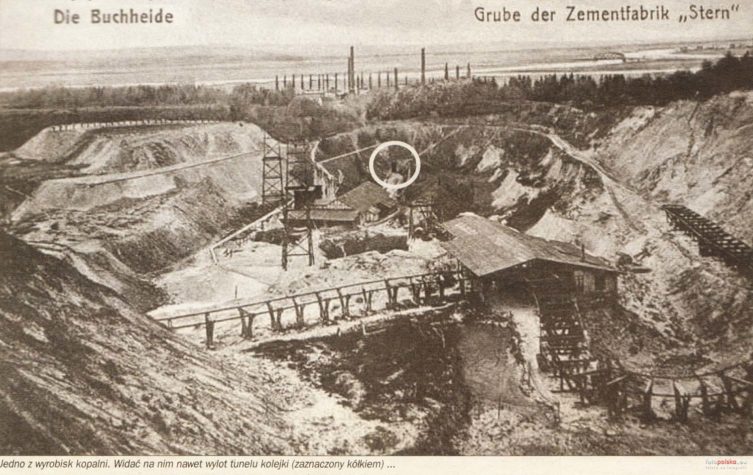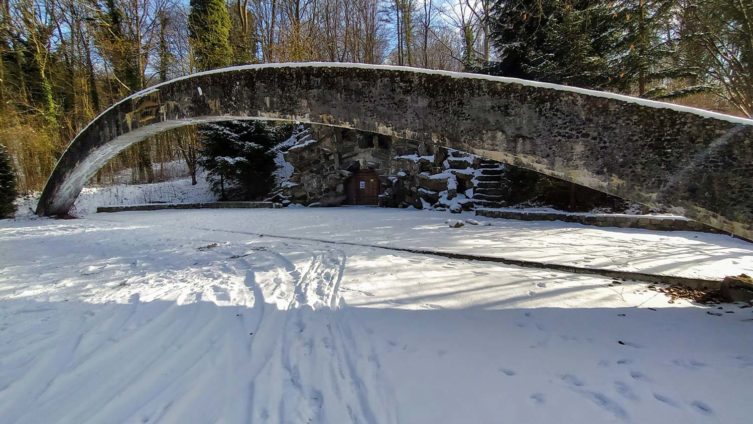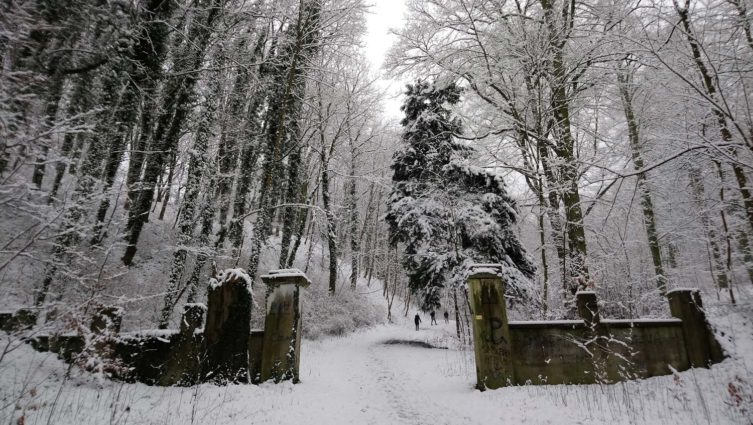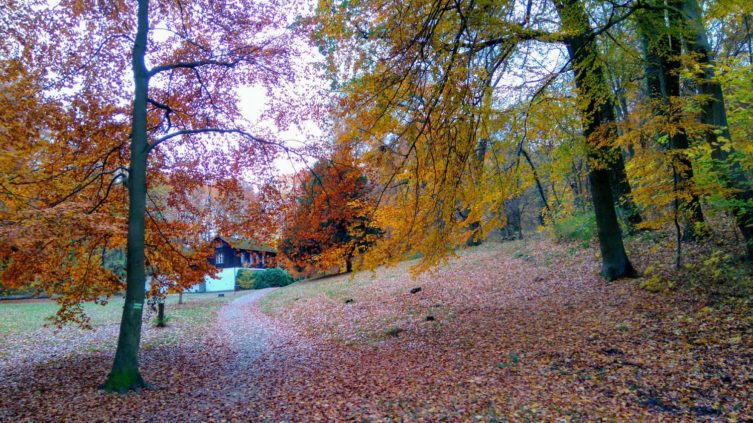Szmaragdowe Lake - interesting facts, attractions, map, routes

Mine
In a place where families with children and lovers go on romantic walks in beautiful natural circumstances, in 1925 there was still a huge and ugly hole in the ground. A hole filled with mining machinery.
There was an opencast chalk and marl mine (marl is a type of sedimentary rock used for the production of cement and fertilizers).

photo source: fotopolska.eu
The mine was established in 1862 and supplied the raw material to the nearby "Stern" cement plant, producing Portland cement. The cement plant was developing dynamically, and the cement it produced was known for its high quality. Of course, the quality of the cement was directly related to the high quality of the local deposits exploited by the mine.
I managed to find a map from 1930, which shows the location of the excavation and the mine heap, the cement plant, the transport channel connecting the cement plant with the measles and other parts of the project.

photo source: fotopolska.eu
I decided to do an experiment. I generated a contemporary map on an appropriate scale and superimposed a contemporary map and a historical map. The effect can be seen below.
On the map overlay obtained in this way, you can clearly see how different parts of the mine and cement plant overlap with what we can see here today.
For those who want to explore the area a little more thoroughly, this overlay can be an interesting help.

1 - Szmaragdowe Lake (mine excavation)
2 - Toepffer Grotto
4 - Widok Hill (mine heap)
9 - Stern cement plant
10 - channel connecting the cement plant with the Oder river
source of the historical map: fotopolska.eu
modern map background: openstreetmap.org
A cement business
For over 60 years, everything was going well (Szczecin then became one of the largest cement production centers in Germany). The mine mined, the cement plant produced and sold cement, the money flowed, and the owners (the Toepffer family) grew richer.

photo source: fotopolska.eu
Albert Eduard Toepffer (son of the first owner of a cement plant, Gustaw Adolf Toepffer) expanded the production with paving tiles and roof tiles.
In order to present potential buyers the possibilities offered by the cement produced in Szczecin, he built an artificial grotto made of cement, and in front of it, two cement arches, on which he placed a small pavilion.
Grota made a great impression on contractors. An orchestra played in the pavilion placed on the arches above the guests' heads. The guests were having fun, dancing, and Toepffer doing more business. The grotto and one of the arches still exist today.

photo source: fotopolska.eu

Helmut Toepffer (grandson of the first owner of the cement plant) also left a permanent mark. Near the grotto, he built an impressive residence of several dozen rooms, furnished with great splendor. He purchased the entrance gate to the residence during an international exhibition in Paris. In the museum hall, which the residence was equipped with, a copy of the sculpture "Moses" by Michelangelo, commissioned in Rome, was placed. The house was filled with original furnishings imported from all over the world.

Suddenly it was all over
July 16, 1925 came. Mining works were carried out at the southern wall of the excavation. Everything was going well until a layer of permeable sand was found.
Years of exploitation of the excavation led to a situation in which the material was obtained from a depth that was well below the groundwater level.
After that, everything happened very quickly. A sudden outflow of groundwater into the excavation took place through the layer of permeable sand. The excavation was taking on water quickly. People were evacuated immediately. Fortunately, nothing happened to anyone.
The excavation was flooded. A lake was formed.


Szmaragdowe Lake
Due to the violent circumstances of the birth of the Emerald Lake, machines that were there at the time of the catastrophe are still resting on its bottom. Hobbyist divers sometimes venture into the depths of the lake to admire the sunken machines. Unfortunately, the waters of the lake are still quite cloudy. Diving in them is very dangerous and swimming, due to the chemical composition of the water, is not recommended.
The lake owes its color (and at the same time its name) to the high content of calcium carbonate, which comes from the calcite filling the pit.

What a beautiful disaster
Ultimately, the disaster in the mine workings led to the creation of an exceptional beauty and recreation area.
Today the lake makes a fantastic impression. Sewn up among the steep slopes of the former excavation, covered with a beautiful forest, crossed by walking paths with places to rest. Here and there, while walking, you can see traces of history telling a story about itself. The bridge over the lake reminds us of the narrow-gauge railway which used to transport the output from the mine. The fragments of buildings that the forest greedily devours, the grotto, and the monuments destroyed with the passage of time remind us of the fortune that was created on the deposits exploited here.


Even the "Oko na Szczecin" viewpoint is located on the artificial View Hill, which used to be a heap where redundant mining material was stored.
Concluding the topic of the Toepffer residence, I would like to add that the residence survived World War II, but did not survive the Soviet army, which ruined and plundered the palace after the end of the war. The work of destruction was completed by seekers of free building material. Only fragments of the gate and small fragments of walls and foundations remain after the residence. A similar fate befell the cement plant.
Near the Emerald Lake you will also come across very interesting relics of a bit later history. Inside the slopes surrounding the lake, there are undergrounds from the times of World War II, with a total length of tunnels of about 700m (available for visiting).

At the top of the rugged lake shore, on the so-called On the Cannon Hill there is a foundation of a huge cannon that had a powerful firepower from the level of the hill.
Right next to the lake you will come across a Sunny Glade, along with the remains of Baresel's Tower ... and that's not all.
The Szmaragdowe Lake and its surroundings are a beautiful and very interesting area. A place where nobody will be bored and where I come back often and willingly.
I recommend it to everyone!


Map of the Emerald Lake
Below is a map of the Emerald Lake with interesting places and walking paths marked.

The path marked in yellow is real and is marked in the field as a yellow trail. The paths marked in red and green are not actually marked with any marks. These are my suggestions that I just marked on the map. Why did I even mark them?
The red trail modifies the yellow trail a bit and runs next to the attractions that the yellow trail avoids.
Example:
When starting your walk from the P1 parking lots, you can first follow the path marked in red from the narrow-gauge railway bridge (8) to the basement (5), then to the Armatnie Hill (6), then the red one to the right to the yellow trail. Then follow the yellow trail to Widok Hill (4), the gates to the Toepffer residence (3), then to the grotto (2) and then a longer bit along the yellow trail to the rest shelter, where you can turn slightly right again (onto the red path), in towards Baresel Tower (7) and back to the parking lot.
The green trail in the field is also not marked in any way, but I drew it because it is my favorite walking route. It is beautiful, picturesque and interesting. It is best to start at the P1 parking lot, then along the red path (8, 5) and down the cannon hill down the path leading down to the moment when narrow, cement steps appear on the left. We go left on these stairs and we go down the stairs to the lake itself. Further on, the path will lead us around the lake alone. I recommend.
The length of the trail around the lake, depending on the chosen path, is from 2,5 to 5 km.

Attractions in the vicinity of the Szmaragdowe Lake
I know from experience that in the field there may be a problem with finding some attractions. The area is wooded and very undulating, which means that visibility is very limited.
So below I am giving the precise GPS coordinates of all places. If you happen to lose your orientation or there is a problem with finding the destination (and I am sure that such a problem will appear in 100%), you can always start the navigation on the phone by clicking on the coordinates provided by me. This should make it much easier to find your target.
The numbering below obviously corresponds to the numbers on the map.
1. Lake Szmaragdowe
53°22’21.4″N 14°37’29.0″E
53.372603, 14.624717 - click and route
2. Toepffer Grotto
53°22’25.0″N 14°37’04.3″E
53.373596, 14.617871 - click and route
3. Gate to Toepffer Residence
53°22’24.9″N 14°37’10.1″E
53.373580, 14.619474 - click and route
4. View hill
53°22’28.7″N 14°37’11.1″E
53.374650, 14.619756 - click and route
5. Underground and Tourist Information Center
53°22’20.4″N 14°37’25.9″E
53.372338, 14.623867 - click and route
6. Cannon Hill
53°22’17.2″N 14°37’22.8″E
53.371445, 14.622995 - click and route
7. remains of Baresel's Tower
53°22’29.3″N 14°37’34.2″E
53.374817, 14.626166 - click and route
8. The narrow-gauge railway bridge
53°22’22.5″N 14°37’29.6″E
53.372905, 14.624897 - click and route
Parking P1, next to the narrow-gauge railway bridge
53°22’24.1″N 14°37’28.2″E
53.373359, 14.624485 - click and route
Parking P2, next to the Toepffer Grotto
53°22’26.0″N 14°37’06.3″E
53.373900, 14.618417 - click and route
Important to me!
Give the article a good rating (5 stars welcome 😀)!It's free, a for me it is very important! The blog lives on visits and thus has a chance to develop. Please do it and ... thank you in advance!
If you like my guides, you will certainly find the one I created useful guide catalog - [click]. There you will find ready-made ideas for your next trips, descriptions of other tourist destinations and an alphabetical list of guides divided into countries, cities, islands and geographical regions.
I also post link to Facebook profile - [click]. Come in and press "Follow"then you will not miss new, inspiring posts.
Unless you prefer Instagram. I'm not a social media demon, but you can always count on something nice to look at on my instagram profile - [click]. The profile will gladly accept any follower who likes it.
I make the content I create available free of charge with copyright, and the blog survives from advertising and affiliate cooperation. So, automatic ads will be displayed in the content of the articles, and some links are affiliate links. This has no effect on the final price of the service or product, but I may earn a commission for displaying ads or following certain links. I only recommend services and products that I find good and helpful. Since the beginning of the blog's existence, I have not published any sponsored article.
Some of the readers who found the information here very helpful, sometimes ask me how you can support the blog? I do not run fundraisers or support programs (type: patronite, zrzutka or "buy coffee"). The best way is to use links. It costs you nothing, and support for the blog is self-generating.
Pozdrawiam

Very well written entry. Good illustrations, best regards